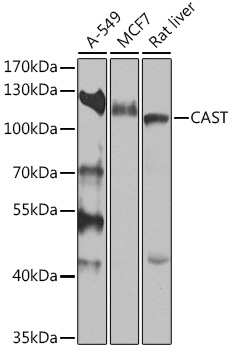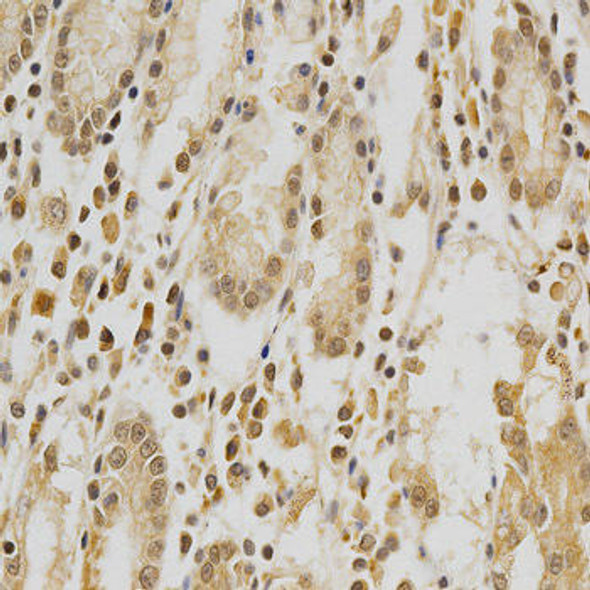Description
Anti-CAST Antibody (CAB16791)
The Cast Rabbit Polyclonal Antibody (CAB16791) is a valuable tool for researchers studying CD300A, a cell surface protein involved in immune regulation. This antibody, produced in rabbits, exhibits high reactivity with human samples and has been validated for use in Western blot applications. By specifically binding to the CD300A protein, this antibody enables accurate detection and analysis in various cell types, making it well-suited for experiments in immunology and cancer research.CD300A, also known as an immune inhibitory receptor, plays a crucial role in maintaining immune homeostasis by modulating inflammation and suppressing allergic reactions.
Its importance in regulating immune responses makes it a promising target for investigating diseases such as cancer, autoimmune disorders, and chronic inflammatory conditions. Understanding the function of CD300A is essential for the development of therapies that can either enhance or suppress immune activity in these disease contexts.Overall, the Cast Rabbit Polyclonal Antibody (CAB16791) offers researchers a reliable tool for investigating the role of CD300A in immune regulation and disease pathogenesis, ultimately contributing to advancements in immunotherapy and treatment strategies for various health conditions.
| Antibody Name: | Anti-CAST Antibody |
| Antibody SKU: | CAB16791 |
| Antibody Size: | 20uL, 50uL, 100uL |
| Application: | WB |
| Reactivity: | Human, Mouse, Rat |
| Host Species: | Rabbit |
| Immunogen: | A synthetic peptide corresponding to a sequence within amino acids 550-650 of human CAST (NP_001177371.1). |
| Application: | WB |
| Recommended Dilution: | WB 1:500 - 1:2000 |
| Reactivity: | Human, Mouse, Rat |
| Positive Samples: | A-549, MCF7, Rat liver |
| Immunogen: | A synthetic peptide corresponding to a sequence within amino acids 550-650 of human CAST (NP_001177371.1). |
| Purification Method: | Affinity purification |
| Storage Buffer: | Store at -20°C. Avoid freeze / thaw cycles. Buffer: PBS with 0.02% sodium azide, 50% glycerol, pH7.3. |
| Isotype: | IgG |
| Sequence: | SDKD LDDA LDKL SDSL GQRQ PDPD ENKP MEDK VKEK AKAE HRDK LGER DDTI PPEY RHLL DDNG QDKP VKPP TKKS EDSK KPAD DQDP IDAL SGDL DSCP S |
| Gene ID: | 831 |
| Uniprot: | P20810 |
| Cellular Location: | |
| Calculated MW: | 63kDa/71- 84kDa |
| Observed MW: | 140kDa |
| Synonyms: | CAST, BS-17, PLACK |
| Background: | The protein encoded by this gene is an endogenous calpain (calcium-dependent cysteine protease) inhibitor. It consists of an N-terminal domain L and four repetitive calpain-inhibition domains (domains 1-4), and it is involved in the proteolysis of amyloid precursor protein. The calpain/calpastatin system is involved in numerous membrane fusion events, such as neural vesicle exocytosis and platelet and red-cell aggregation. The encoded protein is also thought to affect the expression levels of genes encoding structural or regulatory proteins. Alternatively spliced transcript variants encoding different isoforms have been described. |
| UniProt Protein Function: | calpastatin: Specific inhibition of calpain (calcium-dependent cysteine protease). Plays a key role in postmortem tenderization of meat and have been proposed to be involved in muscle protein degradation in living tissue. Belongs to the protease inhibitor I27 (calpastatin) family. 7 isoforms of the human protein are produced by alternative splicing. |
| UniProt Protein Details: | Protein type:Inhibitor Chromosomal Location of Human Ortholog: 5q15 Cellular Component: membrane; cytoplasm; cytosol Molecular Function:protein binding; endopeptidase inhibitor activity; cysteine protease inhibitor activity Disease: Peeling Skin With Leukonychia, Acral Punctate Keratoses, Cheilitis, And Knuckle Pads |
| NCBI Summary: | The protein encoded by this gene is an endogenous calpain (calcium-dependent cysteine protease) inhibitor. It consists of an N-terminal domain L and four repetitive calpain-inhibition domains (domains 1-4), and it is involved in the proteolysis of amyloid precursor protein. The calpain/calpastatin system is involved in numerous membrane fusion events, such as neural vesicle exocytosis and platelet and red-cell aggregation. The encoded protein is also thought to affect the expression levels of genes encoding structural or regulatory proteins. Alternatively spliced transcript variants encoding different isoforms have been described. [provided by RefSeq, Jun 2010] |
| UniProt Code: | P20810 |
| NCBI GenInfo Identifier: | 126302556 |
| NCBI Gene ID: | 831 |
| NCBI Accession: | P20810.4 |
| UniProt Related Accession: | P20810 |
| Molecular Weight: | 63kDa; 71-84kDa |
| NCBI Full Name: | Calpastatin |
| NCBI Synonym Full Names: | calpastatin |
| NCBI Official Symbol: | CAST |
| NCBI Official Synonym Symbols: | BS-17; PLACK |
| NCBI Protein Information: | calpastatin |
| UniProt Protein Name: | Calpastatin |
| UniProt Synonym Protein Names: | Calpain inhibitor; Sperm BS-17 component |
| Protein Family: | Calpastatin |
| UniProt Gene Name: | CAST |
| UniProt Entry Name: | ICAL_HUMAN |




